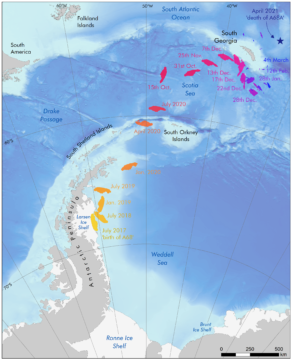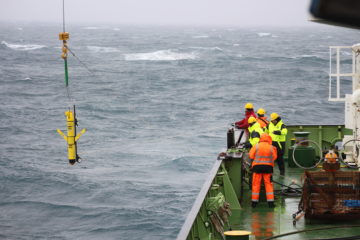The mission to determine the impact of the giant A-68a iceberg on the important marine ecosystem of sub-Antarctic South Georgia is a success according to a team of researchers and engineers, from British Antarctic Survey (BAS) and National Oceanography Centre (NOC). This week (Monday 19 April) the U.S National Ice Center declared 'the end' of the A68 iceberg, because its fragments are now too small to track. This coincides with the return of the mission ship to Southampton in the UK last week (13 April).
The team are piloting two submersible robotic gliders deployed in mid-February from the NOC-operated research ship RRS James Cook. The gliders named 'Doombar - 405' and 'HSB - 439', were launched into the water some 200kms offshore from South Georgia. Their mission was to monitor the effects of the melting of the 'mega-berg' on the ecosystem.
Dr Alexander Brearley, an oceanographer at BAS, who is co-leading piloting of the gliders, says:
"The experiment has provided us with a unique opportunity to understand the impact of a melting and fragmenting iceberg on the both physical properties and ecosystem of the Southern Ocean around South Georgia. Our highly-equipped autonomous vehicles have allowed us to take measurements closer to the icebergs than our research ship could safely manage, giving us new insights into how iceberg meltwater and the mineral dust it carries affects both ocean circulation and productivity of the ecosystem."
The mission was a high risk as gliders are not usually deployed so near icebergs. After a few days, 405 was overtaken by an iceberg and spent two weeks stuck under the ice. However, it extracted itself and was piloted to look at the downstream effects of the iceberg on the most biologically productive regions north of the island. Unfortunately, the team lost connection with the second glider 439, in late February, but are cautiously optimistic that it may re-appear.

BAS oceanographer Dr Povl Abrahamsen, was the mission leader on board the ship. He says:
"We had a short time window to complete this mission, especially when the decline of the iceberg has been so rapid. Whilst risky, we are delighted with the data we have received so far. I'm looking forward to seeing the full-resolution data, when we retrieve the gliders in late May."
The A-68, which covered an area of nearly 6,000 sq km (2,300 sq miles), broke away as a huge iceberg from Antarctica's Larsen C Ice Shelf in 2017. Over the last few months it has been close to South Georgia, where it shattered into countless smaller icebergs.

Data collected on seawater salinity, temperature, and chlorophyll will help the team understand the impact of extremely cold freshwater from the melting ice into a region of the ocean that sustains colonies of penguins, seals and whales. These waters are also home to some of the most sustainably managed fisheries in the world.
Professor Geraint Tarling, an ecologist at British Antarctic Survey, says:
"The threat posed by the A-68a mega-berg to the South Georgia ecosystem was substantial given its sheer size and potential to disrupt all parts of the food web. The glider mission allowed us to obtain unique insights into how the marine environment was affected. The extremely strong currents around South Georgia ultimately came to the island's rescue in diverting the iceberg away from a catastrophic coastal collision. We are now eager to analyse the data to assess how the natural balance of the South Georgia ecosystem was affected by the trail of meltwater and nutrients left in the iceberg's wake."
Maaten Furlong, Head of the Marine Autonomous & Robotics Systems Group at the NOC, says:
"At the National Oceanography Centre, we are immensely proud to have supported this expedition by deploying our gliders to the A-68 iceberg and successfully delivering the science in this challenging region. From NOC's rapid response in preparing two National Marine Equipment Pool gliders at short notice to the collaboration with the BAS team on this highly complex science campaign, the success of this expedition is a testament to the professionalism and flexibility of all involved."
The research expedition to A-68a was funded by the Natural Environment Research Council, the Government of South Georgia and the South Sandwich Islands, and the UK Government's Blue Belt Programme.






